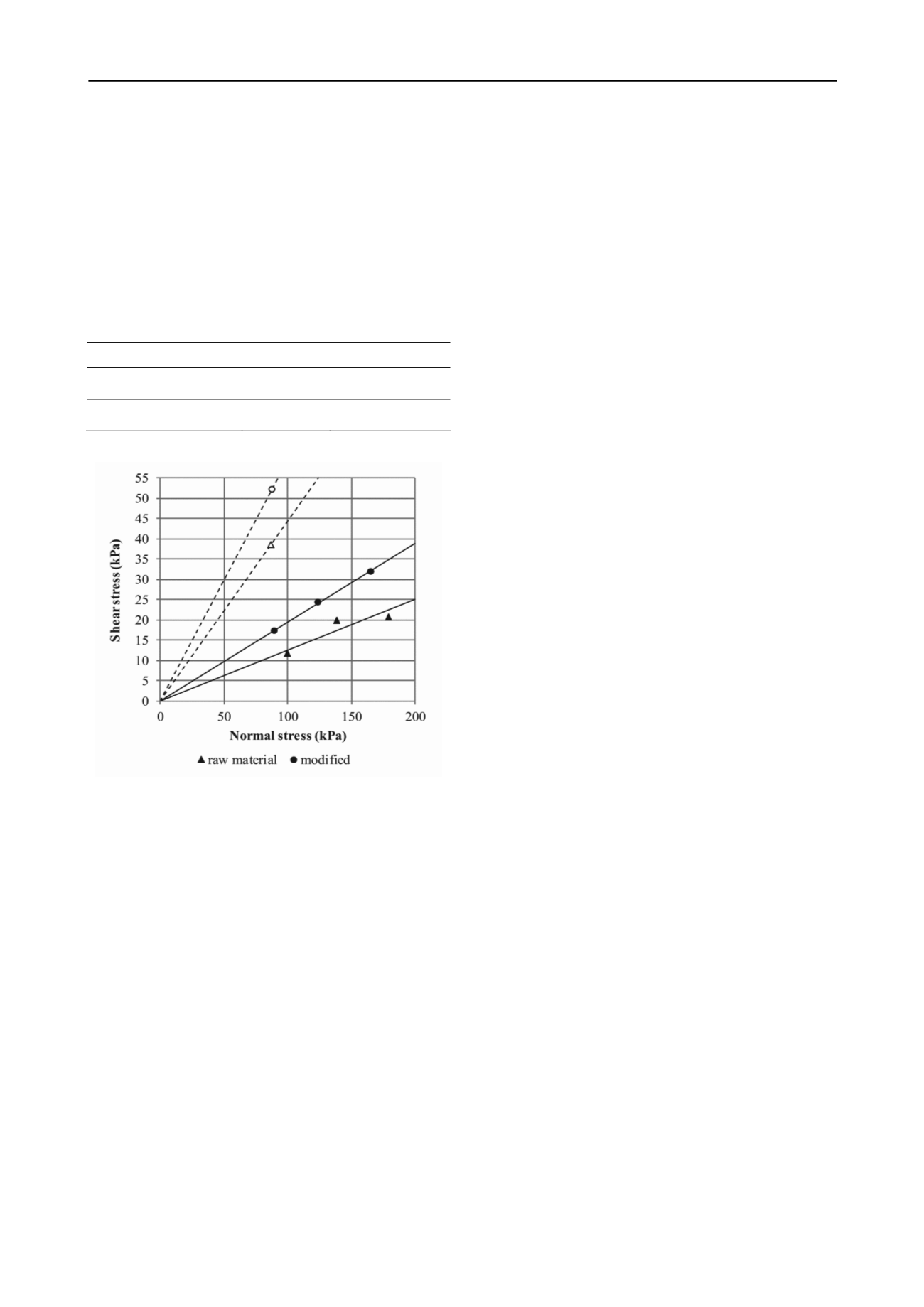
1030
Proceedings of the 18
th
International Conference on Soil Mechanics and Geotechnical Engineering, Paris 2013
shear resistance was measured by a multi-stage procedure with
a constant shear velocity of 0.2 mm/min and three different load
steps for each sample. Figure 7 shows the residual shear stress
after 30 to 40 mm of displacement. Moreover, the first load step
was used to measure one value for the peak shear resistance. By
assuming zero cohesion this peak value was used to derive the
peak friction angle for each material. Table 2 summarises the
friction angles obtained from this data set. It shows that both
peak and residual resistance are increased after chemical
treatment.
Table 2. Strength parameters of bentonite samples. For all values a
rictional material with zero cohesion was assumed.
f
Raw Material
Modified Material
Peak friction angle
24°
31°
Residual friction angle
7°
11°
Figure 7. Results of multi stage ring shear tests on bentonite samples.
The empty symbols represent peak shear resistance of the initial failure
during the first load step loading. Residual state (full symbols) was
reached after 30 to 40 mm of displacement in each load step.
4 CONCLUSIONS
Based on the experimental work on different scales the
following conclusions could be drawn:
The molecular change of the clay minerals on the level of the
surface chemistry results on the particle scale in an aggregation
of small clay minerals to larger and stable particles. The
aggregated, non-swelling particles provide an open pores
system with pores of about 2 µm. Upon wetting these pores are
no longer filled with an expanding clay phase but kept open.
The pore water is not bound as immobile interlayer water and
remains available for circulation.
The compression tests have shown that the new structure is
stable also under stresses up to 800 kPa for both pure bentonites
and quartz/bentonite mixtures. Despite these drastic changes on
the microstructural level, the stiffness is not significantly
affected by chemical treatment. The material strength is
positively influenced by the chemical treatment as both peak
shear resistance and residual shear resistance for the modified
bentonite is higher compared to the raw material. A negative
influence on these mechanical properties can therefore be
excluded.
In summary, the findings are positive indicators for further
development of the technique towards purposely creating zones
of higher permeability in-situ as part of a drainage system in
creeping landslides.
5 ACKNOWLEDGEMENTS
The authors would like to thank Dr. M. Plötze of the ClayLab at
ETH Zurich for his help during chemical laboratory testing.
This work has been supported by grant Nr. 200021-137689
from the Swiss National Science Foundation, Switzerland.
6 REFERENCES
ASTM Standard D 2435, 2004.
One-Dimensional Consolidation
Properties of Soils Using Incremental Loading
, ASTM
International, West Conshohocken, USA.
F. Fernandez, R.M. Quigley, 1985. Hydraulic conductivity of natural
clays permeated with simple liquid hydrocarbons.
Can. Geotech. J.
,
22(2), 205-214.
G. Lagaly, M. Ogawa, I. Dékány, 2006. Clay Mineral Organic
Interactions. In: F. Bergaya, B.K.G. Theng, G. Lagaly, (eds.)
Handbook of Clay Science
, Elsevier, 309-377.
F.T. Madsen, J.K. Mitchell, 1989. Chemical effects on clay hydraulic
conductivity and their determination.
Mitteilungen des IGBM
, ETH
Zürich, 135, 67.
M. Plötze, G. Kahr, 2008. Diagnostic intercalation in clay minerals –
use of Guanidine carbonate.
Proc. of the 4th MECC, Mineralogia
,
33, 132.


